The World and its Religions
Date added: 09/08/18
Introduction
What is covered in this section?
This section of Religious Trends focuses on world-wide religion. There is an article on the 'big picture' that offers a summary of the strength of the world’s religions. This will be followed by a series of articles on individual countries, starting with China and the United States.
Measuring religious adherents
In our Introduction to Religious Trends, we discussed the several ways of counting followers of a religion: devotion, practice, membership and profession. The figures in this section are mainly of those who responded to public censuses and surveys, and so are those who profess to be followers of the faiths in question.
It is likely that such answers will be affected by the social and political climate of the country, with people more likely to follow the state or majority religion or the local political culture or climate. In the UK, about 72% said they were Christian in the 2001 census, but the 2005 English Church Census found just 6.3% attending church services on the surveyed weekend. However, in countries where the church is restricted, the number willing to say they are believers could even be less than those following their faith in secret.
The big picture
The world population is approaching 7 billion and millions of people follow a variety of religions. Religious Trends offers but a summary and points to some sources for deeper research. This section will give some information about other religions but our focus is upon Christianity and its following relative to other faiths. A more detailed spreadsheet is available for download. Figure 1 shows the relative strength of the major religions across the world.
We have used for our main source the CIA World Factbook which gives for most countries the proportion following different faiths. Usually, these are those who profess to follow a faith in a census or survey. Sometimes we have found more detail from the US Department of State ; and for a few countries, we have used a different source. We give references in the spreadsheet.
There are differences in the way such statistics are gathered, for example in the level of detail. Our sources, interpretations and sometimes assumptions are detailed in the spreadsheet that is available for download.
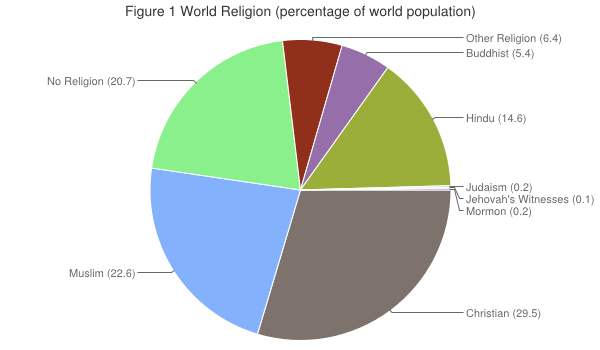
Christianity
Figure 1 shows that Christianity is the biggest religion with 29% of the world population, that is, nearly 2 billion. We have attempted to include the main Trinitarian churches – Catholic, Protestant and Orthodox, but not groups such as Mormons and Jehovah’s Witnesses.
Figure 2 shows that just over half the world’s Christians are Roman Catholic and the remainder split roughly 3:1 Protestant:Orthodox. We have reduced this as much as we can with some assumptions based on other sources, some rather more anecdotal than we would have wished, or by ascribing all to a denomination that is known to dominate. However, for some we have been unable to do this and the dataset available for download records some figures as 'unspecified' and these are included in Figure 2 with 'Christian Other'.
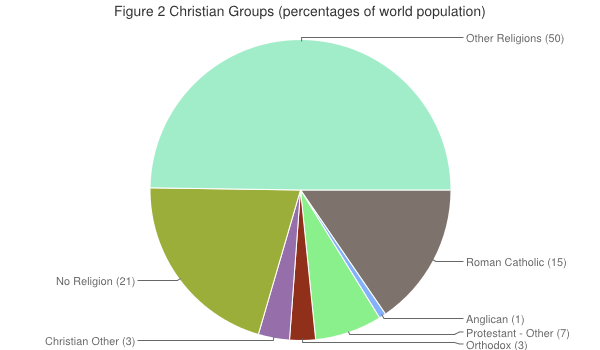
Islam
Muslims form the second biggest religion with 23% or about 1.5 billion adherents. Most are Sunni, with around 12% Shi’a, nearly half of whom live in Iran. See Figure 3. There are some other Islamic groups of such very few numbers that we have not included them in the analysis.
We have used a report by the Pew Forum to enhance the CIA breakdown. Where the CIA does not break down the Muslim population, we have used the percentages from Pew, with negligible proportions rounded to zero.
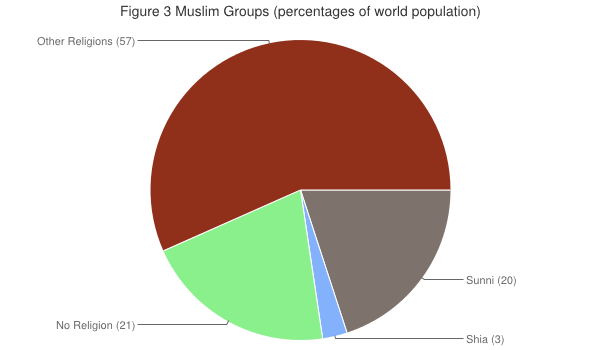
Mormons and Jehovah's Witnessess
Christian Research’s usual practice is to count as main-stream Christians, churches following a Trinitarian basis of belief. We count separately Mormons, Jehovah’s Witnesses and adherents of other faith groups that follow a non-Trinitarian theology involving Jesus Christ. However, the raw data from CIA will not distinguish these groups for many countries.
Fortunately, both the Mormons and Jehovah’s Witnesses publish their own membership statistics so we have used these, reducing the size of the officially measured Christian groups to balance.
These religions, along with Judaism, are small in global terms but we have included them in our analysis as we expect them to be of interest to our Christian readership.
Other Religions
We have compiled figures for Judaism, Buddhism and Sikhism, for which there are reasonable data in the CIA World Factbook or elsewhere. There are also many countries that count people following indigenous beliefs.
All other religions are collated to ‘Religion other or unspecified’. Because practices differ, some followers of our major religions may not be identified in countries where they are very much a minority and some very small groups may have been rounded to zero.
There are of course many millions of followers of particular religions that have been bundled in this category and which may be significant locally.
Data sources
Full details of our sources and interpretation are on the spreadsheet available for download. For most countries, we can ascribe the percentages in the CIA World Factbook to the groups used in our analysis.
For 9 countries, we have used data from the United States Department of State where the breakdown is more detailed than from CIA.
Elsewhere, when neither CIA nor the US State Department provide any figures, we have turned to various sources. For example, for the Cayman Islands and Cuba, information is taken from Operation World. The 2001 United Kingdom Census figure of 71.6% as a total for Christians has no breakdown into denominations. Christian Research broke this down in Religious Trends 4.
Unfortunately, it is notoriously difficult to estimate religious adherents for the world’s most populous country, China. This country is the subject of one of our special articles in which we draw some conclusions from the evidence.
World overview
Countries' largest religion
The map shows the largest religion in each country.
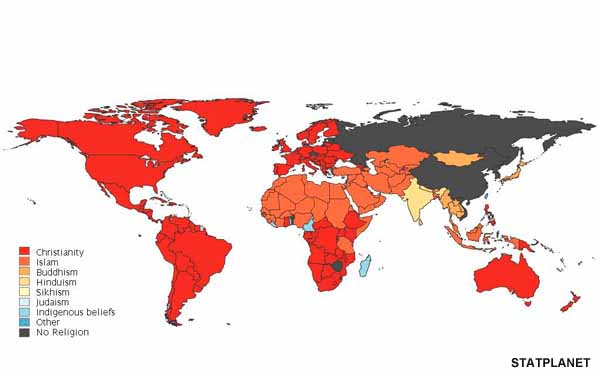
Christianity is dominant in much of the Americas, Europe, Southern Africa and Oceania.
The so called 10/40 Window can be clearly seen as an area where Islam is generally the largest religion. The term refers to those regions of the eastern hemisphere located between 10 and 40 degrees north. It is an area of the world with great poverty and low quality of life, and many governments in the 10/40 Window are formally or informally opposed to Christian work of any kind within their borders.
The Window forms a band encompassing Saharan and Northern Africa, as well as much of Asia. About two-thirds of the world population lives in the 10/40 Window. Islam dominates across North African and through the Arabian Peninsuala, with India, Bangladesh Cambodia, Mynamar (Burma) and Thailand forming a North South block in Asia where Hinduism and Buddhism are the majority religions, before Islam returns again in the islands of South East Asia.
This mapping can not however show the great variations in practice and adherence to the leading religion across both the majority Christian and majority Islamic areas, nor the degree to which traditional religions exist synchronously alongside the main religion. The prevalence of synchronously existing traditional practices is a particularly important factor especially in Africa and South East Asia.
Comparative strength of Christianity
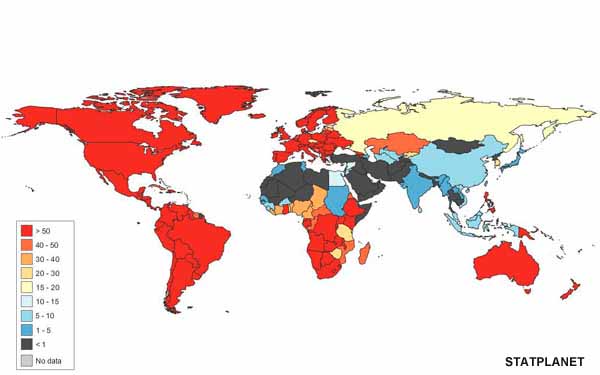
This map shows the comparative strength of Christianity across the world. It is particularly notable that countries with a dominant Islamic relgion tend to have very few Christians, wheras other countries with non Christian majorities, such as India, or no overall majority religion such as China, have much more substantial Christian populations. The exception to this trend in Africa, is the Sudan, but this is explicable because of the geographic separation of faith groups in this country, with the North being predominantly Islamic and the South generally Christian, or following traditional religions. The effect may of course disappear with the up coming referendum, which may grant the South independence.
The apparently relatively low numbers of Christians across Russia and the Former Soviet Union, do not adequately reflect the growing influence of the Orthodox church on life and policy across this vast area. This is almost certainly because the Russian census, from which the figures are based, measured more active followers and excluded the more passive or nominal believers that in most other countries' censuses would have said they were Russian Orthodox.
Back